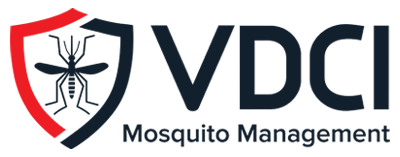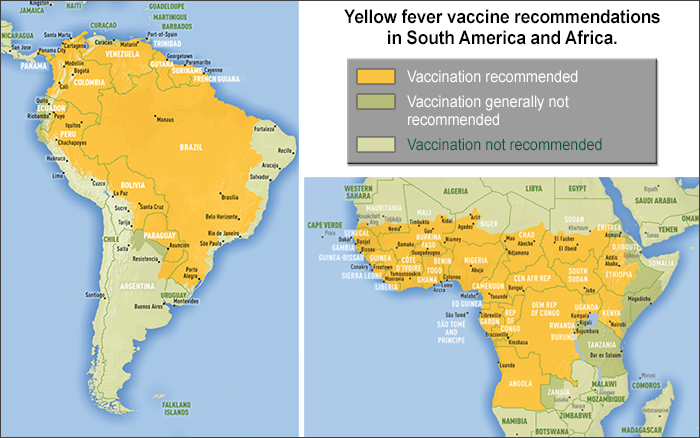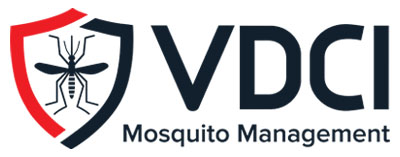
What is Yellow Fever and How Does it Spread?
Yellow fever is an acute viral disease. The yellow fever virus is a Flavivirus with a 400-year history. The disease originated in Africa and then spread to South America in the 1600s. The first reports of yellow fever in the U.S. occurred in Charleston, SC and Philadelphia, PA in 1699. Today, yellow fever is found in South America and Africa and causes around 200,000 infections and 30,000 deaths each year. Fortunately, there is an effective vaccine against yellow fever.
Yellow fever is spread through three transmission cycles; urban, sylvatic, and intermediate. The disease is mainly transmitted to humans through the bite of an infected mosquito, Aedes aegypti, and these mosquitoes acquire the virus by feeding on other infected humans. This is known as the urban cycle. The sylvatic, or jungle, cycle involves transmission of the virus through non-human primates in the wild. Humans can then become infected by these mosquitoes when visiting or working in the jungle. Vectors involved in the jungle cycle include Aedes africanus in Africa or mosquitoes of the genus Haemagogus and Sabethes in South America. An intermediate cycle exists where semi-domestic mosquitoes of the Aedes species serve as vectors, and both human and non-human primates serve as reservoirs for the disease.
| Symptoms of Yellow Fever |
- Most people infected will experience no symptoms.
- For those who do become ill, symptoms include fever, chills, headache, nausea and loss of appetite. Other symptoms may include muscle pains, particularly in the back.
- Most patients recover after about 4 days, though approximately 15% experience a second, more serious, phase of the illness.
- The second phase of yellow fever involves high fever and liver damage that causes yellow skin. Failure of multiple organs may occur as well. Mortality rate among severe cases of the disease is estimated at 20 to 50%.
- There is no cure for yellow fever.
- Treatment is symptomatic and involves making the patient more comfortable.
Yellow Fever Vaccine
![]()
There is a vaccine for the disease, and it is strongly recommended or required for those traveling to high-risk areas in South America and Africa.
The CDC maintains a list of specific countries where yellow fever vaccination is required or recommended for travelers. The vaccine is recommended for those nine months of age and older. Reactions to the vaccine are typically rare and mild, though there are risks of more severe reactions. Travelers should consult their healthcare provider to discuss vaccination if they are planning to travel to areas at risk for the disease.
Yellow Fever and the United States
Yellow fever was introduced in the U.S. in the late 1600s, with major epidemics occurring from 1793 through 1905. Today, endemic areas are restricted to Africa and South America. However, Aedes aegypti mosquitoes are found in the southern coastal states and the risk of individuals becoming infected while traveling and then returning to the U.S. does exist.
A Global View of Yellow Fever
In sub-Saharan Africa, yellow fever occurs in regular epidemic patterns and accounts for the vast majority of all human cases and deaths attributable to yellow fever. However, there are also periodic, more unpredictable outbreaks of urban yellow fever throughout the continent. At least 32 African countries are now considered at risk of yellow fever, with a total population of 610 million people at risk.
Yellow fever is also endemic in 10 South and Central American countries and on several Caribbean islands. Bolivia, Brazil, Colombia, Ecuador, Peru, and Venezuela are considered at greatest risk. Although the disease usually causes only sporadic cases and small outbreaks, nearly all major urban centers in the American tropics have been re-infested with Aedes aegypti. Due to the loss of organized mosquito control programs and subsequent re-infestation of the primary vector, Latin America is now at greater risk of urban epidemics than at any time in the past 50 years.
Know Your Aedes Mosquiotes
Aedes aegypti, the yellow fever mosquito, is characterized by a silvery-white “lyre-shaped” pattern of scales on its thorax. It is a peridomestic species found not far from human dwellings. They are primarily early morning or late afternoon feeders, but females can also take a bloodmeal at night under artificial illumination. Typically, Ae.aegypti fly only a few hundred yards from their breeding sites.
The species utilize containers to breed, and educating the public on how to eliminate their backyard larval habitats is one key to keeping these invaders under control. Larvae can be found in a variety of artificial containers, including buckets, tires, cans, and flower pots. Homeowners should also inspect rain gutters for clogs, gardening equipment, and backyard children’s toys.
Controlling Aedes aegypti and Yellow Fever
An Integrated Mosquito Management (IMM) program is essential to helping prevent mosquito bites and transmission of serious vector diseases in the United States. As part of an effective IMM program, VDCI recommends a 4-pronged approach to target all phases of the mosquito’s life cycle.
1: Public Education
Mosquito control professionals can only do so much, and this is why we rely on a well-educated public in order to have a successful mosquito control program. Educating the public empowers people to take control of the mosquitoes breeding in their back yard and gives them the tools needed to reduce mosquito annoyance.
2: Surveillance
Surveillance allows us to detect mosquito species in a given area as well as any changes in populations. With this valuable data, we are able to more effectively time larvicide applications and more accurately target adulticide activities.
3: Larval Mosquito Control
Our trained field technicians inspect both known sources of standing water and any newly discovered sites for the presence of mosquito larvae. Eliminating mosquitoes prior to their becoming adults is an important element of controlling mosquito-borne diseases because it stops mosquitoes before they acquire the virus and have the opportunity to transmit it to people.
4: Adult Mosquito Control
When necessary, adulticide applications are conducted with EPA-approved pesticides that are used in the safest and most environmentally sound way possible. Additionally, VDCI regularly tests adult mosquitoes and takes all appropriate measures to prevent them from developing resistance; thereby, minimizing the number of applications needed to control the population.
VDCI is a company built on the foundations of public health, ethics, professionalism, and technical expertise. We establish vector management programs that are based on an understanding of the underlying vector’s ecology and rooted in the current science of environmentally sound control measures.
[backlink]



